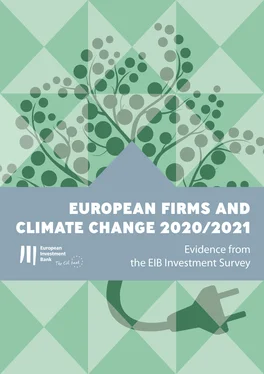European firms and climate change 2020/2021
Evidence from the EIB Investment Survey
August 2021

About the European Investment Bank
The European Investment Bank is the world’s biggest multilateral lender. The only bank owned by and representing the interests of the EU countries, the EIB finances Europe’s economic growth. Over six decades the Bank has backed start-ups like Skype and massive schemes like the Øresund Bridge linking Sweden and Denmark. Headquartered in Luxembourg, the EIB Group includes the European Investment Fund, a specialist financer of small and medium-sized enterprises.
Overview
Contents
Are European firms climate-ready? Evidence from the EIB Investment Survey 2020
1. Introduction
2. From perceptions to action: How do firms perceive and invest in climate change?
2.1 Physical climate risks are becoming a reality for firms
2.2 Firms tend to underestimate transition risks as their impacts are not as easily observable as physical risks
3. European investments to tackle climate change are gaining momentum
4. Barriers to climate-related investments: Uncertainty about regulation and taxation cited as the biggest threat
5. The bottom line
Annex 1: Questionnaire
Annex 2: Country scoreboard
Country scoreboard: SMEs
Country scoreboard: Large Firms
Annex 3: Country dashboards
The COVID-19 recovery is an opportunity to refocus businesses’ attention on climate investments.The European Union’s recovery strategy aims to overhaul the economy by making it more green and digital. The climate objectives encompassed in EU rebuilding efforts could accelerate the fight against climate change and contribute to the European Union’s pledge to become the first carbon-neutral continent by 2050.
Climate change poses two kinds of risks for firms: direct physical risks and transition risks.Physical risks, such as those caused by acute weather events, are easier for firms to observe and understand. Transition risks are less evident, as they depend on global commitments to reduce their economies’ reliance on fossil fuels. Nearly 60% of European firms believe that climate change poses a physical risk, compared with 50% in the United States, according to the EIBIS 2020.
Firms in the European Union and the United States tend to disregard the importance of transition risks, however.Firms have a harder time understanding the threat the transition poses to demand for their products, their supply chain and their reputation. Despite the costs associated with transition risks, the majority of firms in the United States and European Union seem unaware of these risks. Firms that are aware of the risks the transition poses to their business activities are more likely to invest in climate measures.
Climate change’s ultimate impact may still be hazy for many businesses, but more EU firms are investing to protect themselves than US firms.Around 45% of EU firms say that have invested in climate change measures, according to the EIBIS 2020, compared with 32% of US firms. Northern European firms are the most active investors, followed by firms in Southern Europe. At the same time, investments in energy efficiency continue to rise. Nearly half (47%) of EU firms surveyed say they have invested in energy efficiency, a ten percentage point rise compared to 2019.
Uncertainty over regulation and taxation continues to hamper climate investments.EU firms are more likely to face constraints when investing in climate than their US counterparts. The most frequently cited obstacle is uncertainty about regulation and taxation (43%), followed by investment costs (41%).
To build a sustainable economy, Europe needs a comprehensive strategy with a clear regulatory framework, strong climate policies and proactive public and private investments.The right framework would help create a virtuous circle, in which the private and public sector work together to invest in greening the European economy.

Debora Revoltella
Director, Economics Department
European Investment Bank
Конец ознакомительного фрагмента.
Текст предоставлен ООО «ЛитРес».
Прочитайте эту книгу целиком, купив полную легальную версию на ЛитРес.
Безопасно оплатить книгу можно банковской картой Visa, MasterCard, Maestro, со счета мобильного телефона, с платежного терминала, в салоне МТС или Связной, через PayPal, WebMoney, Яндекс.Деньги, QIWI Кошелек, бонусными картами или другим удобным Вам способом.














